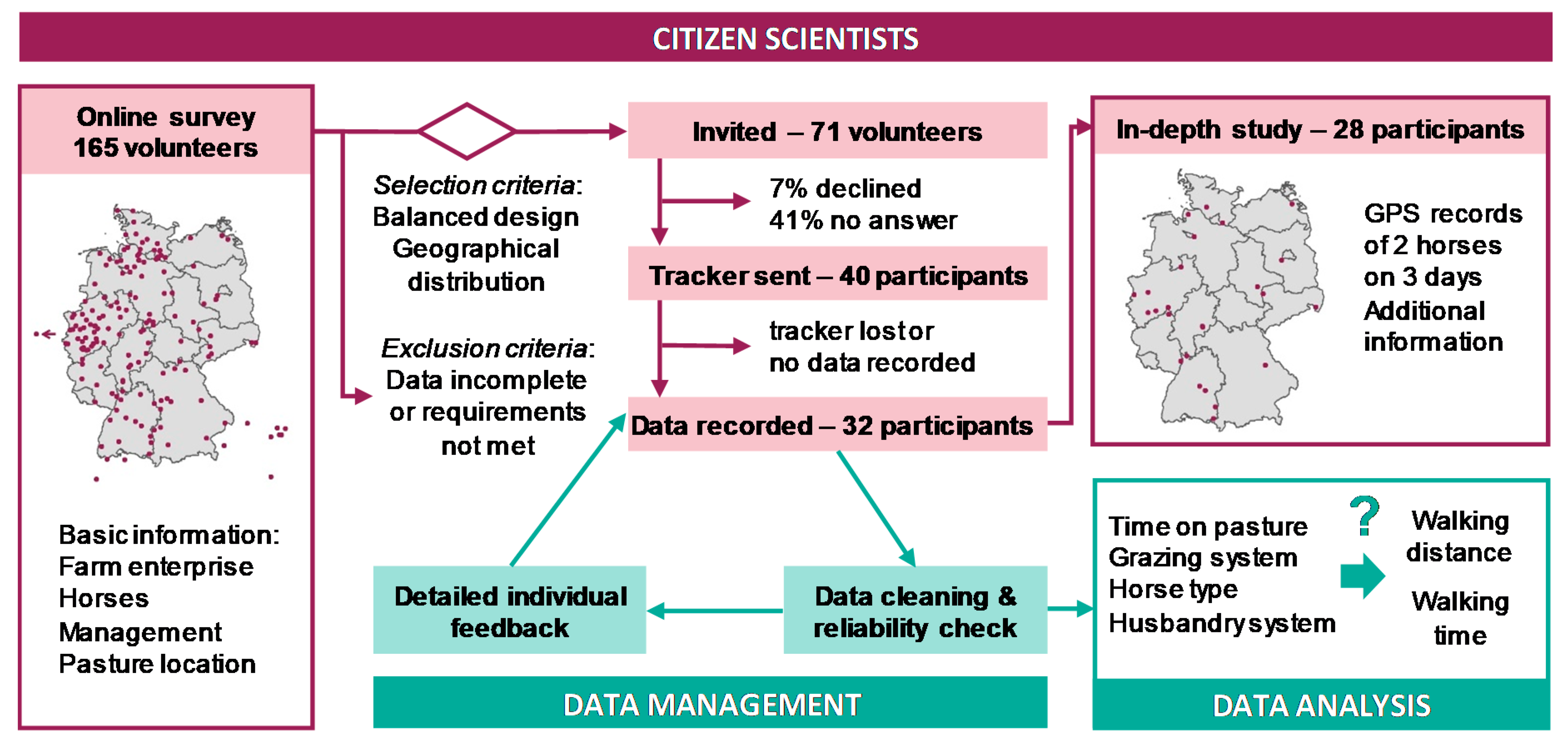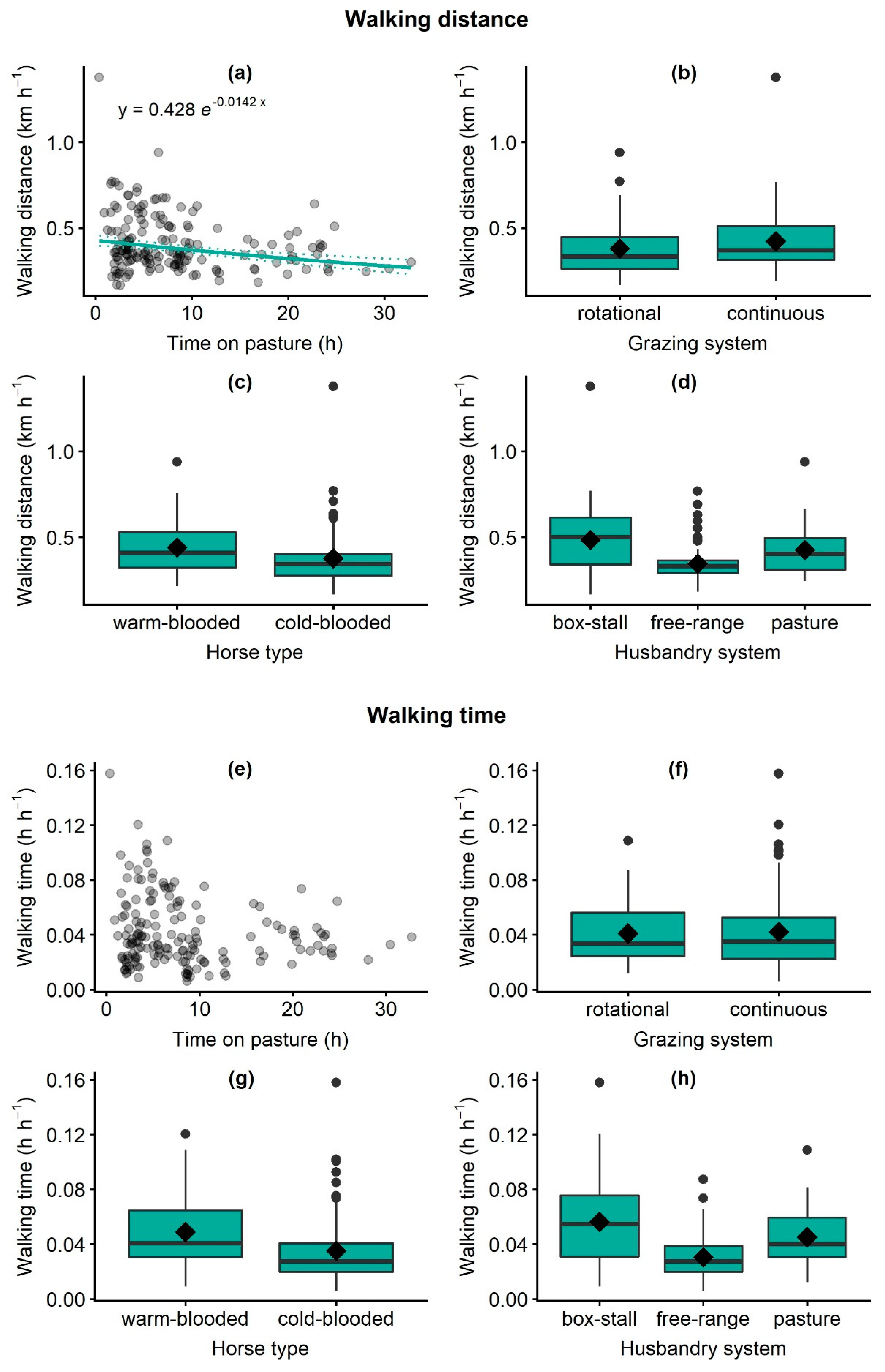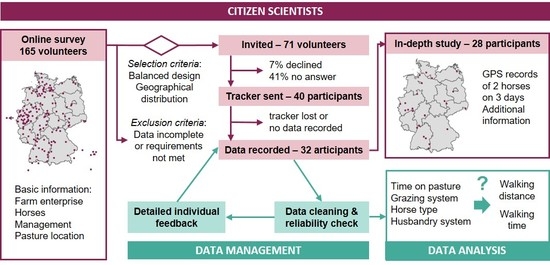Using a Citizen Science Approach with German Horse Owners to Study the Locomotion Behaviour of Horses on Pasture
Abstract
:1. Introduction
2. Materials and Methods
2.1. Study Design
2.2. Selection of Participants
2.3. GPS Units
2.4. Data Recording
2.5. Data Preparation
2.6. Statistical Analysis of Grazing Behaviour
3. Results
3.1. Experiences with Citizen Science
3.2. Locomotion Behaviour of Horses on Pasture
4. Discussion
4.1. Locomotion Behaviour of Horses on Pasture
4.2. Citizen Science as a Research Methodology in Horse Husbandry
5. Outlook
Supplementary Materials
Author Contributions
Funding
Acknowledgments
Conflicts of Interest
References
- Bonney, R.; Cooper, C.B.; Dickinson, J.; Kelling, S.; Phillips, T.; Rosenberg, K.V.; Shirk, J. Citizen Science: A developing tool for expanding science knowledge and scientific literacy. BioScience 2009, 59, 977–984. [Google Scholar] [CrossRef]
- Silvertown, J. A new dawn for citizen science. Trends Ecol. Evol. 2009, 24, 467–471. [Google Scholar] [CrossRef] [PubMed]
- Citizen Science-Partner with Scientists to Answer Real-World Questions|National Marine Sanctuaries. Available online: https://sanctuaries.noaa.gov/involved/citizen-science.html (accessed on 29 December 2019).
- Dehnen-Schmutz, K.; Foster, G.L.; Owen, L.; Persello, S. Exploring the role of smartphone technology for citizen science in agriculture. Agron. Sustain. Dev. 2016, 36, 25. [Google Scholar] [CrossRef] [Green Version]
- Newman, G.; Wiggins, A.; Crall, A.; Graham, E.; Newman, S.; Crowston, K. The future of citizen science: Emerging technologies and shifting paradigms. Front. Ecol. Environ. 2012, 10, 298–304. [Google Scholar] [CrossRef] [Green Version]
- Ryan, S.F.; Adamson, N.L.; Aktipis, A.; Andersen, L.K.; Austin, R.; Barnes, L.; Beasley, M.R.; Bedell, K.D.; Briggs, S.; Chapman, B.; et al. The role of citizen science in addressing grand challenges in food and agriculture research. Proc. R. Soc. B Biol. Sci. 2018, 285, 20181977. [Google Scholar] [CrossRef] [PubMed]
- Theobald, E.J.; Ettinger, A.K.; Burgess, H.K.; DeBey, L.B.; Schmidt, N.R.; Froehlich, H.E.; Wagner, C.; HilleRisLambers, J.; Tewksbury, J.; Harsch, M.A.; et al. Global change and local solutions: Tapping the unrealized potential of citizen science for biodiversity research. Biol. Conserv. 2015, 181, 236–244. [Google Scholar] [CrossRef] [Green Version]
- Kosmala, M.; Wiggins, A.; Swanson, A.; Simmons, B. Assessing data quality in citizen science. Front. Ecol. Environ. 2016, 14, 551–560. [Google Scholar] [CrossRef] [Green Version]
- Simoniello, C.; Jencks, J.; Lauro, F.M.; Loftis, J.D.; Weslawski, J.M.; Deja, K.; Forrest, D.R.; Gossett, S.; Jeffries, T.C.; Jensen, R.M.; et al. Citizen-Science for the Future: Advisory Case Studies From Around the Globe. Front. Mar. Sci. 2019, 6, 225. [Google Scholar] [CrossRef] [Green Version]
- Hanrahan, L.; Geoghegan, A.; O’Donovan, M.; Griffith, V.; Ruelle, E.; Wallace, M.; Shalloo, L. PastureBase Ireland: A grassland decision support system and national database. Comput. Electron. Agric. 2017, 136, 193–201. [Google Scholar] [CrossRef]
- Toomey, A.H.; Domroese, M.C. Can citizen science lead to positive conservation attitudes and behaviors? Hum. Ecol. Rev. 2013, 20, 50–62. [Google Scholar]
- Beza, E.; Steinke, J.; van Etten, J.; Reidsma, P.; Fadda, C.; Mittra, S.; Mathur, P.; Kooistra, L. What are the prospects for citizen science in agriculture? Evidence from three continents on motivation and mobile telephone use of resource-poor farmers. PLoS ONE 2017, 12, e0175700. [Google Scholar] [CrossRef] [PubMed] [Green Version]
- Steinke, J.; van Etten, J.; Zelan, P.M. The accuracy of farmer-generated data in an agricultural citizen science methodology. Agron. Sustain. Dev. 2017, 37, 32:1–32:12. [Google Scholar]
- Zacharias, M.; Ressi, W. Biodiversity monitoring by farmers to sustain ecosystem services of high nature value grasslands in Austria. Rural Areas Dev. 2018, 15, 219–229. [Google Scholar]
- Rüdisser, J.; Tasser, E.; Walde, J.; Huemer, P.; Lechner, K.; Ortner, A.; Tappeiner, U. Simplified and still meaningful: Assessing butterfly habitat quality in grasslands with data collected by pupils. J. Insect Conserv. 2017, 21, 677–688. [Google Scholar] [CrossRef] [Green Version]
- Kaartinen, R.; Hardwick, B.; Roslin, T. Using citizen scientists to measure an ecosystem service nationwide. Ecology 2013, 94, 2645–2652. [Google Scholar] [CrossRef]
- Roetman, P.; Tindle, H.; Litchfield, C. Management of pet cats: The impact of the Cat Tracker citizen science project in South Australia. Animals 2018, 8, 190. [Google Scholar] [CrossRef] [Green Version]
- Jouven, M.; Vial, C.; Fleurance, G. Horses and rangelands: Perspectives in Europe based on a French case study. Grass Forage Sci. 2016, 71, 178–194. [Google Scholar] [CrossRef]
- Schmitz, A.; Isselstein, J. Wieviel Grünland wird in Deutschland für Pferde genutzt? Berichte Über Landwirtsch. Z. Für Agrarpolit. Landwirtsch. 2018, 96. [Google Scholar] [CrossRef]
- Hölker, S. Typologie der deutschen Pferdehaltung-Eine empirische Studie mittels Two-Step-Clusteranalyse. Berichte Über Landwirtsch. Z. Für Agrarpolit. Landwirtsch. 2016, 94. [Google Scholar] [CrossRef]
- Bomans, K.; Dewaelheyns, V.; Gulinck, H. Pasture for horses: An underestimated land use class in an urbanized and multifunctional area. Int. J. Sustain. Dev. Plan. 2011, 6, 195–211. [Google Scholar] [CrossRef] [Green Version]
- Zasada, I.; Berges, R.; Hilgendorf, J.; Piorr, A. Horsekeeping and the peri-urban development in the Berlin Metropolitan Region. J. Land Use Sci. 2013, 8, 199–214. [Google Scholar] [CrossRef]
- Bott, R.C.; Greene, E.A.; Koch, K.; Martinson, K.L.; Siciliano, P.D.; Williams, C.; Trottier, N.L.; Burk, A.; Swinker, A. Production and environmental implications of equine grazing. J. Equine Vet. Sci. 2013, 33, 1031–1043. [Google Scholar] [CrossRef]
- Singer, J.W.; Bobsin, N.; Kluchinski, D.; Bamka, W.J. Equine stocking density effect on soil chemical properties, botanical composition, and species density. Commun. Soil Sci. Plant Anal. 2001, 32, 2549–2559. [Google Scholar] [CrossRef]
- Martinson, K.L.; Siciliano, P.D.; Sheaffer, C.C.; McIntosh, B.J.; Swinker, A.M.; Williams, C.A. A review of equine grazing research methodologies. J. Equine Vet. Sci. 2017, 51, 92–104. [Google Scholar] [CrossRef]
- van Klink, R.; Nolte, S.; Mandema, F.S.; Lagendijk, D.D.G.; WallisDeVries, M.F.; Bakker, J.P.; Esselink, P.; Smit, C. Effects of grazing management on biodiversity across trophic levels–The importance of livestock species and stocking density in salt marshes. Agric. Ecosyst. Environ. 2016, 235, 329–339. [Google Scholar] [CrossRef] [Green Version]
- Hampson, B.A.; Morton, J.M.; Mills, P.C.; Trotter, M.G.; Lamb, D.W.; Pollitt, C.C. Monitoring distances travelled by horses using GPS tracking collars. Aust. Vet. J. 2010, 88, 176–181. [Google Scholar] [CrossRef]
- Hampson, B.A.; de Laat, M.A.; Mills, P.C.; Pollitt, C.C. Distances travelled by feral horses in ‘outback’ Australia: Distance travelled by feral horses. Equine Vet. J. 2010, 42, 582–586. [Google Scholar] [CrossRef] [Green Version]
- Hennig, J.D.; Beck, J.L.; Scasta, D.J. Spatial ecology observations from feral horses equipped with global positioning system transmitters. Hum. Wildl. Interact. 2018, 12, 75–84. [Google Scholar]
- Zeitler-Feicht, M.H. Handbuch Pferdeverhalten, 2nd ed.; Eugen Ulmer: Stuttgart, Germany, 2008. [Google Scholar]
- Claudi, K.; Hoy, S. Measurements of distances moved by horses in an active stable by GPS. Tierärztl. Umsch. 2013, 68, 486–490. [Google Scholar]
- Langlois, B. Inter-breed variation in the horse with regard to cold adaptation: A review. Livest. Prod. Sci. 1994, 40, 1–7. [Google Scholar] [CrossRef]
- R Core Team. R: A Language and Environment for Statistical Computing; R Foundation for Statistical Computing: Vienna, Austria, 2018. [Google Scholar]
- Pinheiro, J.; Bates, D.; DebRoy, S.; Sarkar, D. Nlme: Linear and Nonlinear Mixed Effects Models; R Package Version 3.1–137. R Core Team. Available online: https://CRAN.R-project.org/package=nlme (accessed on 5 July 2018).
- Fox, J.; Weisberg, S. An R Companion to Applied Regression, 2nd ed.; Sage: Thousand Oaks, CA, USA, 2011. [Google Scholar]
- Pikuła, R.; Zaborski, D.; Grzesiak, W.; Smugała, M. Locomotor activity analysis based on habitat, season and time of the day in Polish Konik horses from reserve breeding using the Global Positioning System (GPS). Indian J. Anim. Res. 2019, B1072. [Google Scholar] [CrossRef]
- Rehm, G. Auswirkungen Verschiedener Haltungsverfahren auf die Bewegungsaktivität und die Soziale Aktivität bei Hauspferden; Aktuelle Aspekte der Ethologie in der Pferdehaltung; FN Verlag: Warendorf, Germany, 1981; pp. 81–101. [Google Scholar]
- Sato, F.; Tanabe, T.; Murase, H.; Tominari, M.; Kawai, M. Application of a wearable GPS unit for examining interindividual distances in a herd of Thoroughbred dams and their foals. J. Equine Sci. 2017, 28, 13–17. [Google Scholar] [CrossRef] [PubMed] [Green Version]
- Rose-Meierhöfer, S.; Standke, K.; Hoffmann, G. Auswirkungen verschiedener Gruppengrößen auf Bewegungs- aktivität, Body Condition Score, Liege-und Sozialverhalten bei Jungpferden. Züchtungskunde 2010, 82, 282–291. [Google Scholar]
- Hoffmann, G.; Bentke, A.; Rose-Meierhöfer, S.; Berg, W.; Mazetti, P.; Hardarson, G.H. Influence of an active stable system on the behavior and body condition of Icelandic horses. Animal 2012, 6, 1684–1693. [Google Scholar] [CrossRef] [Green Version]
- Jackson, J. Paddock Paradise: A Guide to Natural Horse Boarding; Star Ridge Publishing: Harrison, AR, USA, 2016. [Google Scholar]
- Rook, A.J.; Dumont, B.; Isselstein, J.; Osoro, K.; WallisDeVries, M.F.; Parente, G.; Mills, J. Matching type of livestock to desired biodiversity outcomes in pastures—A review. Biol. Conserv. 2004, 119, 137–150. [Google Scholar] [CrossRef]
- Minet, J.; Curnel, Y.; Gobin, A.; Goffart, J.-P.; Mélard, F.; Tychon, B.; Wellens, J.; Defourny, P. Crowdsourcing for agricultural applications: A review of uses and opportunities for a farmsourcing approach. Comput. Electron. Agric. 2017, 142, 126–138. [Google Scholar] [CrossRef] [Green Version]
- Van Etten, J.; Beza, E.; Calderer, L.; Van Duijvendijk, K.; Fadda, C.; Fantahun, B.; Kidane, Y.G.; Van De Gevel, J.; Gupta, A.; Mengistu, D.K.; et al. First experiences with a novel farmer citizen science approach: Crowdsourcing participatory variety selection through on-farm triadic comparisons of technologies (TRICOT). Exp. Agric. 2019, 55, 275–296. [Google Scholar] [CrossRef] [Green Version]
- Dickinson, J.L.; Zuckerberg, B.; Bonter, D.N. Citizen Science as an Ecological Research Tool: Challenges and Benefits. Annu. Rev. Ecol. Evol. Syst. 2010, 41, 149–172. [Google Scholar] [CrossRef] [Green Version]
- Pearce-Higgins, J.W.; Baillie, S.R.; Boughey, K.; Bourn, N.A.D.; Foppen, R.P.B.; Gillings, S.; Gregory, R.D.; Hunt, T.; Jiguet, F.; Lehikoinen, A.; et al. Overcoming the challenges of public data archiving for citizen science biodiversity recording and monitoring schemes. J. Appl. Ecol. 2018, 55, 2544–2551. [Google Scholar] [CrossRef] [Green Version]
- Rossiter, D.G.; Liu, J.; Carlisle, S.; Zhu, A.-X. Can citizen science assist digital soil mapping? Geoderma 2015, 259, 71–80. [Google Scholar] [CrossRef]


| Average Daily Time on Pasture | |||
|---|---|---|---|
| Grazing system | total | <8 h | >8 h |
| continuous | 19 | 9 | 10 |
| rotational | 21 | 11 | 10 |
| (a) Variable | Category | Online survey | In-depth study | ||||||
| Farms | Total | 165 | 28 | ||||||
| Enterprise | Hobby | 121 | 14 | ||||||
| Commercial | 44 | 14 | |||||||
| Grazing system | Continuous | 84 | 18 | ||||||
| Rotational | 81 | 10 | |||||||
| Average time on pasture | < 8 h | 51 | 15 | ||||||
| > 8 h | 114 | 13 | |||||||
| Herd structure | Mixed | 100 | 15 | ||||||
| Mares only | 28 | 6 | |||||||
| Geldings only | 37 | 7 | |||||||
| Horses | Total | 330 | 56 | ||||||
| Horse type | Cold-blooded | 129 | 29 | ||||||
| Warm-blooded | 201 | 27 | |||||||
| Husbandry system | Box-stall stable | 113 | 17 | ||||||
| Free-range stable | 105 | 29 | |||||||
| Pasture | 112 | 10 | |||||||
| (b) Variable | Online survey | In-depth study | |||||||
| mean | sd | min | max | mean | sd | min | max | ||
| Pasture size (ha) * | 2.2 | 7.9 | 0.2 | 100 | 1.2 | 1.1 | 0.2 | 4.8 | |
| Herd size (n) | 7 | 6.9 | 2 | 51 | 8.3 | 7.4 | 2 | 30 | |
| Stocking density (LU ha−1) † | – | – | – | – | 11.9 | 17.7 | 2.5 | 97.5 | |
| Horse age (a) | 12.1 | 4.1 | 6 | 22 | 12.3 | 4.1 | 6 | 22 | |
| Response Variable | Explanatory Variable | Co-Variable | Rm² | ||||
|---|---|---|---|---|---|---|---|
| Name | p Value | F Value | Name | p Value | F Value | ||
| Walking distance (km h−1) | Time on pasture | 0.0212 | 5.47 | Pasture size | 0.0499 | 4.23 | 0.143 |
| Grazing system | 0.4806 | 0.51 | 0.0698 | 3.59 | 0.086 | ||
| Horse type | 0.9309 | 0.01 | 0.0669 | 3.66 | 0.077 | ||
| Husbandry system | 0.0979 | 2.55 | 0.0543 | 4.10 | 0.148 | ||
| Walking time (h h−1) | Time on pasture | 0.4639 | 0.54 | Horse sex | 0.0082 | 8.15 | 0.067 |
| Grazing system | 0.9197 | 0.01 | 0.0086 | 8.03 | 0.053 | ||
| Horse type | 0.2402 | 1.44 | 0.0072 | 8.51 | 0.075 | ||
| Husbandry system | 0.0445 | 3.53 | 0.0054 | 9.27 | 0.181 | ||
© 2020 by the authors. Licensee MDPI, Basel, Switzerland. This article is an open access article distributed under the terms and conditions of the Creative Commons Attribution (CC BY) license (http://creativecommons.org/licenses/by/4.0/).
Share and Cite
Schmitz, A.; Tonn, B.; Schöppner, A.-K.; Isselstein, J. Using a Citizen Science Approach with German Horse Owners to Study the Locomotion Behaviour of Horses on Pasture. Sustainability 2020, 12, 1835. https://doi.org/10.3390/su12051835
Schmitz A, Tonn B, Schöppner A-K, Isselstein J. Using a Citizen Science Approach with German Horse Owners to Study the Locomotion Behaviour of Horses on Pasture. Sustainability. 2020; 12(5):1835. https://doi.org/10.3390/su12051835
Chicago/Turabian StyleSchmitz, Anja, Bettina Tonn, Ann-Kathrin Schöppner, and Johannes Isselstein. 2020. "Using a Citizen Science Approach with German Horse Owners to Study the Locomotion Behaviour of Horses on Pasture" Sustainability 12, no. 5: 1835. https://doi.org/10.3390/su12051835






